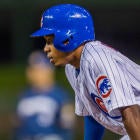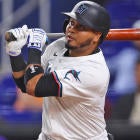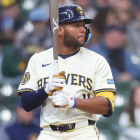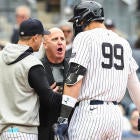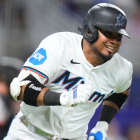When something extraordinary happens on a major-league field, announcers are likely to invoke a commonly-used expression. Catch a baseball stick to a catcher's chest protector, spot a walkoff inside-the-park home run, or witness a man carrying a piano around the bases, and they'll hit you with this bit of wisdom: Go to a baseball game, and there's a chance you'll see something you've never seen before.
This is exactly what we got Sept. 8 at Nationals Park. In his fifth major-league season, after forging a career of futility at the plate, Terrance Gore finally delivered his first hit.
Gore's own resume aside, his base knock in the opener of that Cubs-Nats doubleheader was one of the most inconsequential hits you will ever see. It came with the Cubs already getting blown out, in what would ultimately be a 10-3 loss. It also ran counter to Gore's entire raison d'etre in baseball. With 26 stolen bases but just one hit (and 13 at-bats) over his five-year, 56-game MLB career, no player holds a more ultra-specialized role than Gore does.
Scouts use the 20-to-80 scale to gauge every player's tools; by that measure, Gore is an easy 80, the highest grade possible. More than just straight-line speed, Gore is also skilled at reading pitchers, enabling him to pile up those 26 career steals while being caught just four times. This year, he's already swiped five bases (without getting caught), despite appearing in just eight games, and making it to the plate just three times.
Now think about how often major-league games get decided by one run, and how pivotal results in one-run games can be to a team's fortunes. The Dodgers have already played in 42 one-run games this season, going just 21-21 in those games. Contrast that record to the Rockies' sparkling 25-14 mark in one-run games, and you start to understand how the Rockies could be clinging to first place in the NL West, with the Dodgers currently tied for the final wild-card spot -- despite L.A. sporting a run differential 145 runs better(!) than Colorado's.
If players like Gore exist, wielding the power to swing close games with their legs, and results in close games have the power to significantly impact baseball's standings, then the question must be asked: Why don't more teams carry a Terrance Gore on the roster?
The short answer is that GMs and managers have assembled small villages full of pitchers on their rosters, and show no signs of slowing down that trend. Every year, starting pitchers throw fewer and fewer innings, turning games over to bullpens full of fresh flamethrowers who can negate the cursed third-time-through-the-order penalty. The Rays have taken full-house pitching strategies to the next level, resigning themselves to the idea that only two or three starters are likely to be both healthy and productive at the same time and instead opening games with short stints by relievers. The result of all that pitcher hoarding is an increasingly short bench for every team. That would seem to leave no room for a player like Gore, who can potentially swing a close game with his legs, but is a liability in every other way.
Or does it? I turned to the number-crunchers at MLB.com to see just how often a weapon like Gore could be effectively deployed in a game. The parameters were as follows: Seventh inning or later, two teams separated by no more than one run, with a base available to be stolen. Here's what we found:
| YEAR | CHANCES (IN PAs) | TOTAL PAs | PERCENTAGE |
|---|---|---|---|
2013 | 8,480 | 23,961 | 35.4% |
2014 | 8,320 | 23,612 | 35.2% |
2015 | 7,840 | 22,421 | 35.0% |
2016 | 7,438 | 21,330 | 34.9% |
2017 | 7,010 | 19,678 | 35.6% |
2018 | 6,928 | 19,722 | 35.1% |
The "Total PAs" column refers to all situations in which it's the seventh inning or later, and both teams are within one run of each other. The "Chances" column tallies the number of plate appearances in which it's the seventh inning or later, the two teams are separated by no more than one run, and there's a base available to be stolen. Simply put, MLB teams play lots of close games, and there are tons of opportunities for speedsters to turn potential losses into wins, with the help of speed and a little derring-do.
This is how Terrance Gore got to the big leagues in the first place. The Royals tapped him in the 20th round of the 2011 amateur draft, a lowly 606th overall. A product of Gulf Coast Community College in Panama City, Florida, Gore wasn't much of a hitter, couldn't throw, and despite his blazing speed, possessed iffy instincts for an outfielder. What he could do was run. For Royals general manager Dayton Moore, that was a profile well worth gambling on that late in the draft.
"Back when I was farm director for the Braves in the 90s, Bobby [Cox] would ask for someone who could run every year -- but we just never seemed to get a guy like that," said Moore. "When we would sign six-year free agents, we would load up on guys who could run but not necessarily hit all that well. So we'd have something like three players every season sitting at Triple-A who fit that profile -- Esix Snead, Damon Hollins, guys like that. I told our scouting director every year I wanted to draft at least one guy who could steal bases, hopefully with a no-fear approach and a go mentality. When I went to Kansas City, Terrance was a product of that approach for our group."
In his four years with the Royals, Gore played in just 49 regular-season games and stepped to the plate just 14 times, a batting record that makes him look more like a relief pitcher than a key offensive player. Unlike many other speed merchants who can add a little more value as a late-inning defensive replacement, Gore's defense didn't afford him many chances in the field either, as he made just 10 outfield appearances over that four-year stretch. Still, K.C. manager Ned Yost squeezed every drop of value he could out of his 5-foot-7, 165-pound secret weapon. When Mike Moustakas reached base in the late innings of any close game, you could count on Gore taking his place. Ditto for Salvador Perez and Alex Rios. Even athletic left fielder Alex Gordon would occasionally cede his spot on the basepaths to Gore. In those 49 games, Gore grew into the most terrifying pinch-runner in the league, swiping 21 bases and scoring 14 runs.
Moore remembers the moment he knew the Royals had a game-changer on their hands. On Sept. 25, 2014, K.C. was fighting to make the playoffs for the first time in 29 years. It was the eighth inning of a crucial series opener against the White Sox, and glacially slow DH Billy Butler had just knocked in the go-ahead run in the top of the eighth. Realizing that margin might not hold up, Yost summoned Gore from the dugout to pinch-run. Gore immediately took off, stealing second base with ease. Alex Gordon followed with a chopper to short. The ball found just enough daylight to give Gordon an infield hit; when White Sox shortstop Alexei Ramirez bobbled it for a split second, Gore came all the way around to score from second, on a ball that never left the infield.
When the Royals crashed the postseason that way and zoomed all the way to the World Series, Gore became an avatar for K.C.'s ultra-fast, ultra-aggressive band of upstarts.
"Other teams could not defend that element of our game," said Moore. "They couldn't stop it."
After the Royals' back-to-back runs to the Fall Classic, the Royals would learn exactly how terrified other teams were of Gore's speed. At the 2016 trade deadline, multiple suitors called to inquire about Gore. Moore demurred, hoping K.C. could leap back into contention in 2017. More than that, the Royals hoped that a new collective bargaining agreement would allow teams to expand to 26-man active rosters. While other clubs fantasized about eighth and ninth relievers, Kansas City had that spot earmarked for just one man: Their jack-of-one-trade, Gore.
That roster expansion never materialized, but the Royals hung onto Gore anyway -- in large part because he was out of minor-league options, and no team could find room to carry him on its roster before the annual round of Sept. 1 call-ups. On Aug. 15 of this year, the Cubs took the plunge anyway, acquiring Gore for cash considerations.
Gore's five steals and two runs scored in September show that he's already making an impact. But beyond mere results, both the Royals and Cubs spoke often about The Process over the past few years, and carrying Gore for the stretch run is an example of out-processing opponents. Consider this: On Sept. 5, the Braves trailed the Red Sox by a run in the bottom of the ninth inning. Hoping to make something happen against beastly closer Craig Kimbrel, the Braves pinch-ran with two outs and a man on first base. Out of the game went slow-footed catcher Tyler Flowers. In his place, Atlanta subbed in ... rookie pitcher Touki Toussaint.
Thanks to strong performances by other players down the stretch, along with a September swoon by rival Philadelphia, the Braves will cruise to a division title despite punting on September baserunning reinforcements, even as the Cubs try to hang on for dear life in the NL Central. But in a nail-biter of a race against the hard-charging Brewers, turning even one potential loss into a win could make all the difference. If the Cubs can find the right situation to get Gore into a game at some point in the season's final two weeks, that season-turning moment may well come into play.
In the meantime, 29 other teams can watch Gore do his thing this September, and maybe just maybe consider adding a Gore of their own in the future.
"Most organizations have an 80 runner somewhere," said Baseball Prospectus prospects writer Jeff Paternostro. "It's generally considered to be the most common elite tool, although fastball velocity may have passed it by now. And functionally even the 70 speed guys are viable for this, we are talking a tenth-of-a-second down the line."
Fangraphs prospects writer Eric Longenhagen agreed that teams could do a better job of deploying speed-only players in big spots. "There are about 4,000 minor-league hitters and if you buy that the player population's speed is normally distributed, then 2-3 percent of those players have 70-grade or better speed," he said. "These are guys who get down the line in four seconds flat or faster, the guys who are moving more than 30 feet per second at peak, the kind of speed Gore has. So that means there are about 80 players in the minors who can run like that, and I'd probably round up on that number a little bit because some prospects have probably been a number of players who were identified as prospects only because they're elite runners."
"It's rare for the scope of an individual player's development to be limited to, or even focused on, basestealing. I've seen some experimentation. I watched the 2016 [rookie-level Arizona League] Dodgers deploy Jordan Schafer, who was 29 or 30 at the time, in this role as if they were prepping for a late-season big-league role like Gore's. He entered as a pinch-runner for seven straight games and tried to steal each time."
Now here's the dream scenario: A player who makes Gore look like the most well-rounded player in the league. During Oakland's glory days in the 1970s, eccentric owner Charlie Finley delighted in finding raw athletes to help his club. In 1974, the A's stumbled on Herb Washington, a world-class sprinter with no discernible baseball skills, except an ability to cause a cool breeze as he ran by. That year, Washington spent the entire season on the big-league roster. He stole an impressive 29 bases, and scored 29 runs. He appeared in 92 games in '74 ... and never once came to the plate, or played the field. Despite his blazing speed, his lack of baseball instincts meant that even when trying to steal, he sometimes struggled -- 16 CS to go with those 29 SB, which is very different than Gore's high success rate.
One day, a team is going to load up on Ben Zobrist types, forming an ultra-versatile roster that can take a chance at the end of its bench. That same team is going to eschew carrying a trillion relief pitchers on the active roster, the last of which would inevitably do little but gather dust, or pitch in mop-up duty. When that happens, the dream could come alive once more. The next Herb Washington will fuse with the next Terrance Gore, and deliver us an impossibly fun player, put on this Earth to do one thing: Run like no player has ever run before.













